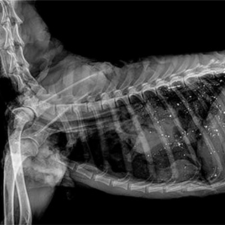A Hidden Danger in Donated Game Meat: Why Lead Contaminated Meat Demands Our Attention
Written by Adrian Wood, MPH

Every year, millions of pounds of hunted game meat are donated to food banks across the United States. While these donations provide a critical source of protein for food-insecure families, new research reveals an overlooked health hazard: lead contamination from hunting ammunition.
Approximately 95% of hunters use lead ammunition (Balog-Way et al. 2023). Unlike other types of ammunition, lead bullets fragment into thousands of tiny pieces on impact. Even after this meat is processed and cooked, tiny lead fragments too small to be noticed while eating remain in the meat. When a lead bullet shatters on impact, it scatters particles of lead throughout the surrounding tissue as far as 18 inches from the entry point. Some of the fragments are too small to be removed during processing and can be too small to detect visually or even by x-ray. A recent unpublished study from New York (Nye et al.) found that 19% of venison packages donated to NY food banks contained lead, with one sample containing up to 617% of the FDA’s interim reference level for children. Notably, some lead-contaminated samples had no visible metal fragments on x-rays, showing that even radiographic inspection can miss dangerous contamination.
These findings raise serious public health questions, particularly given the lack of required screening or warning labels in most states. Minnesota and Iowa are currently the only states with regulations specific to this lead exposure risk. Minnesota requires x-ray screening of donated meat and discarding of samples with visible lead contaminants, while Iowa issues warning labels with distributed venison packages. Researchers from Ohio interviewed stakeholders from Ohio food banks and found that none of the stakeholders interviewed were aware of the risks posed by lead fragments in donated game meat (LeBron et al., 2025). Unlike Minnesota, which uses mandatory x-ray screening, Ohio largely relies on meat processors, many of whom apply only minimal safety measures such as the removal flesh immediately surrounding the bullet entrance areas.
Pennsylvania has one of the country’s largest hunting communities and a robust venison donation culture. During the 2023-24 hunting season, Pennsylvania hunters donated a record-breaking 261,672 pounds of venison from 6,905 deer and six elk statewide. Food insecurity affects 1 in 8 Pennsylvanians (PA DOH, 2022). Many of these families find donated meat essential and may eat it several times a week. With food insecurity affecting millions of Pennsylvanians, including many children, lead-contaminated meat could be silently harming those it’s meant to nourish. Pennsylvania currently lacks statewide protocols for screening or labeling donated game meat, putting it in the same vulnerable position as Ohio and New York. Given the state’s deep-rooted hunting traditions and large rural population, all efforts to replace lead ammunition with non-lead ammunition (i.e., copper) would reduce lead exposure.
Dr. Marilyn Howarth and I are exploring outreach and research opportunities to address this important public health issue in Pennsylvania. Food donations are meant to heal, not harm. The findings from both New York and Ohio show that a lack of oversight and awareness around game meat donations can inadvertently introduce lead into the diets of low-income families. With a few states already modeling practical safety measures, it’s time for Pennsylvania, and the rest of the country, to look at how we ensure food safety across the charitable system. By implementing screening of donated meat and exploring alternatives to lead-based ammunition, we can protect the most vulnerable. Public health and community compassion can, and should, go hand in hand.